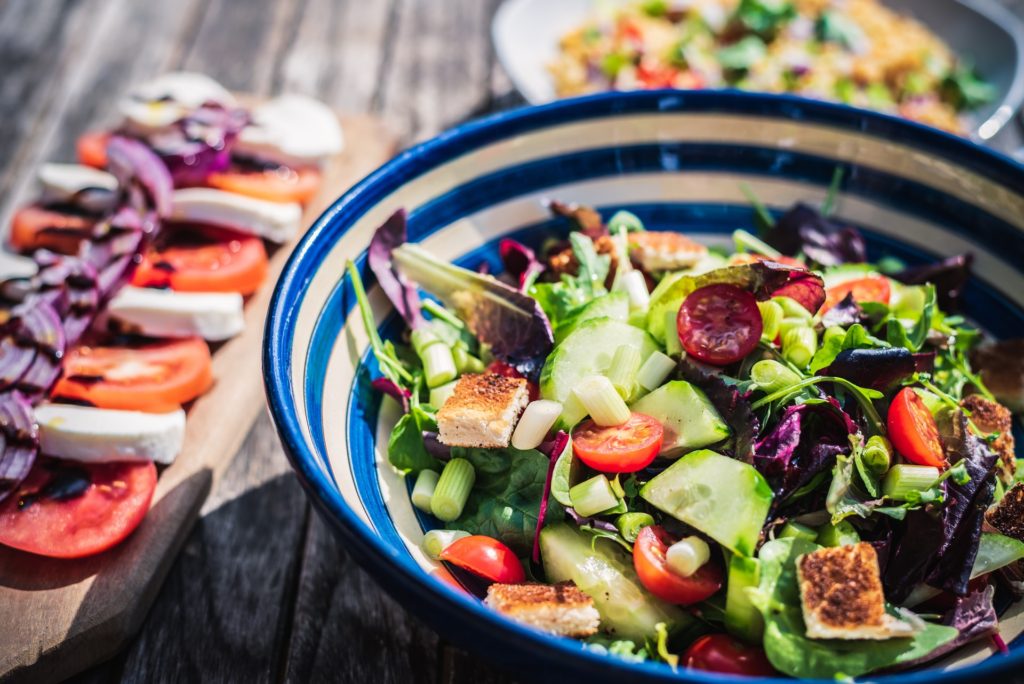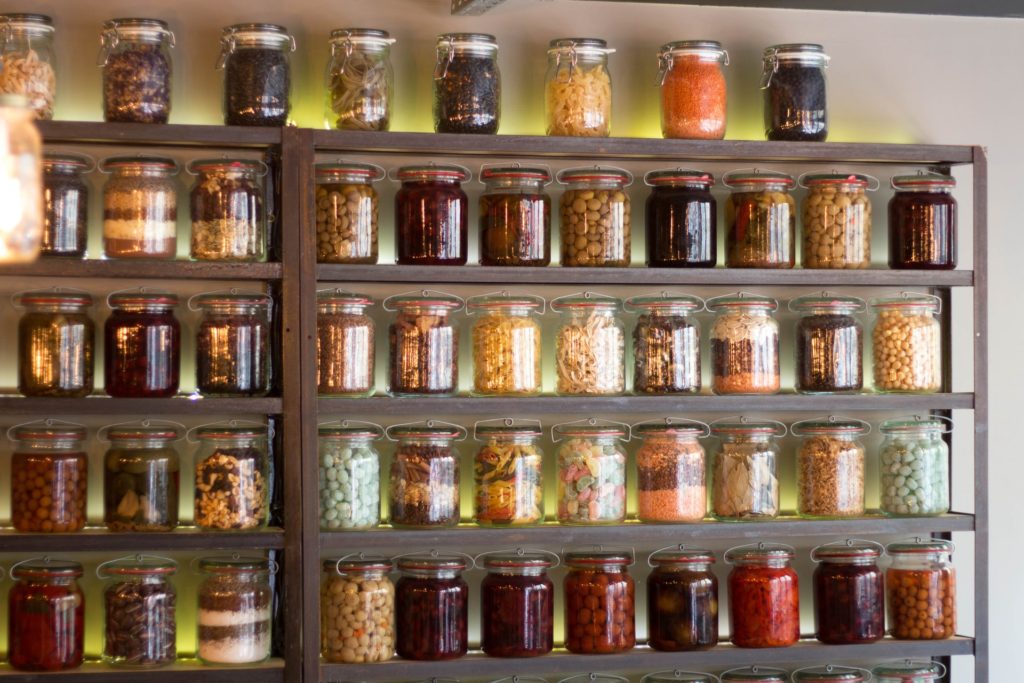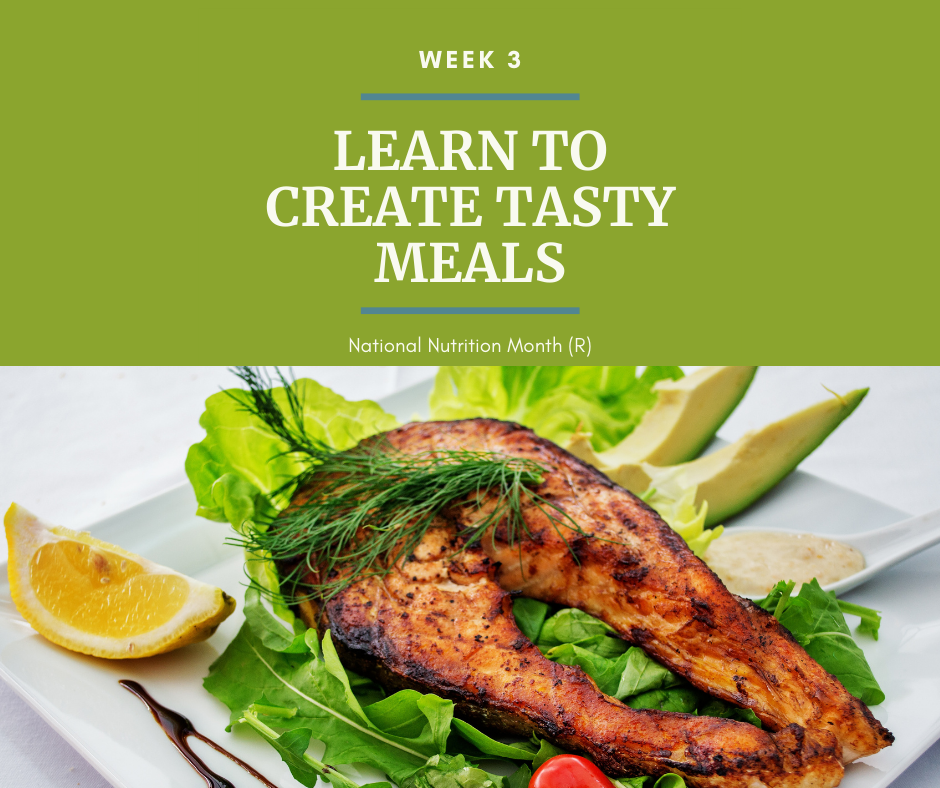It’s hard to believe we’re sliding into the third week of March. It’s harder to believe that we’re already into Week 3 of National Nutrition Month®! The Academy of Nutrition and Dietetics has put together a month-long informational campaign focusing, and Week 3 is all about learning to create tasty meals.
Learn to Create Tasty Meals
“Good nutrition” and “tasty meals” seems like an oxymoron. It conjures up ideas of cardboard and bitter tasting food, or having to do away with luscious add-ins like fat, butter, mayo and oil. The truth is, creating tasty meals is so much easier than you think!
Make a salad a meal

A salad is more than a precursor to dinner. In fact, a great salad can be a whole meal! If you recall the MyPlate.gov approach to eating, which includes vegetables, proteins, grains, and fruit, you can get creative and combine all the same elements into a tasty and satisfying salad. But beware – a salad can also be calorie gluten, so it pays to be judicious about how you build your salad.
Go Green
Start with some mixed greens, baby spinach, or roman lettuce as your base. If those are too bitter, try opting for bibb or butter lettuce. They have a milder taste, much like iceberg lettuce, but are more nutritious. Pack in some more vegetables, such as red cabbage, carrots, tomatoes, cucumbers, or peppers.
Pick your protein
Next, add some protein. Toss in some steak, chicken, or shrimp. Or you can add some canned tuna. There are some yummy flavored tuna packets out there now that can add an interesting zing to your salad. If none of that sounds appealing, don’t forget that hard-boiled eggs are also a great source of protein. Chop one up and toss it in there!
Grab some grains
Now let’s look for some grains. It can be cooked quinoa or even some whole wheat pasta. If you haven’t acquired a taste for whole wheat pasta, regular pasta will work too.
Fill in with fruit
If you’re thinking that fruit can’t or shouldn’t belong in a salad, guess again! They are a great balance to the bitterness of the mixed great and compliment the sweeter ones quite well. Add a cupped handful of sliced strawberries, grapes, mandarin orange, or grapefruit segments. Or you can top with dried cranberries; after all, they’re fruit too!
Dress it up
Finally, top it off with a delicious low-cal dressing. This is where most salads lose their status as a “healthy” meal. First, we either add too much; if you measure it out, 2 tablespoons is actually plenty. Second, we go for creamy dressings like ranch or blue cheese rich with sour cream, mayo and cheese, all of which add up to way too many added fats. If the creamy variety of a dressing is the only thing that will get you to eat a salad in the first place, try one that uses non-fat or low-fat yogurt as a base. I’m betting you won’t even be able to taste the difference.
Viola! You’ve just created tasty meal!
My favorite cook books
Prior to the advent of the internet, I regularly subscribed to magazines such as Bon Appetit and Gourmet to expand my meal creation repertoire. That was 20 years ago, and now sites like Pinterest are the go-to resource for recipes. I still am a big fan of NYT Cooking.
However, when I started counting macros a few year ago, I didn’t care for (translation = understand) Pinterest, and needed something in my hand to better understand how to combine macro counting with cooking. For that, I pick up a few cookbooks. With them, I learned out to cook real meals using real food, and managed to lose a lot of weigh in the process.
Each one has several tasty meals that I love and even adapted to suit my tastes. If you’re not sure how to create a healthy, tasty meal, consider an old-fashioned cook book or two!
Keep healthful ingredients on hand

I’ve always had a well-stocked pantry and freezer and often said that some enterprising person could come into my house and create a divine tasty meal of what in there. As I’ve experiments with new foods and flavors, my pantry and freezer have grown beyond egg noodles and cream of mushroom soup and into more healthful options.
New kitchen staples
It took a minute (okay, over 40 years) to experiment with different foods. I credit my friends, with whom eating was a quintessential social experience. Some of my best memories with my friends were over a shared meal.
As a result, my pantry staples expanded greatly. It now include thing like black beans, canned artichoke hearts, quinoa, enchilada sauce (both green and red!), and canned pumpkin, to name a few. They join the previous staples, such as whole peeled tomatoes, chopped tomatoes, and chopped green chilies. I also keep all kinds of oils, cooking wines and broths, since they add so much flavor with few calories.
My freezer has chopped broccoli, mixed vegetables, pie crust and plus frozen shrimp. It’s quite an eclectic mix and all ready for a few additions to make some amazing meals.
With all of these staples, pulling together a tasty meal in short order should be easy to accomplish.
Multi-purpose vegetables
Multi-purpose vegetables are those I can use in any meal. Fresh or frozen broccoli and fresh spinach are the two that I use most. Frozen or fresh broccoli is excellent in scrambled eggs, and fresh broccoli I will eat as a whole meal by itself. Fresh spinach is another vegetable that I love in my scrambled eggs or in a salad.
Both are key ingredients in a quiche, and this is where that frozen pie crust freezer staple comes in handy. A yummy quiche can be a great breakfast, lunch or dinner. That’s three tasty meals right there!
Another great thing about multi-purpose vegetables is that it’s a great way help you meet your goal of eating 5 – 7 servings of fruits and vegetables every day.
Batch cook hard boiled eggs
Healthy foods made portable increase the odds of them getting eaten. Think about it. If you don’t have the time to plan for or make a healthy meal, hungry may drive you to make unhealthy choices.
This is why I batch cook hard boiled eggs. They are handy and portable, and can be a filling snack or tasty meal.
I was skeptical about jumping on the Instant Pot band wagon, but I’m glad I did. I don’t make everything in there, but it sure does cut down on prep time. Whereas I used to make only 3 or 4 hard boiled eggs in a pot on the stove, I now cook up to 8 hard boiled eggs at a time in my instant pot, and they’re done in minutes.
What do I do with eight egg hard-boiled eggs? Well, on my salad-meal days, one goes in there. For breakfast on the go, I’ll grab 4 hard boiled eggs and use 1 whole egg and three egg whites, chop it all up with a mustard and ½ a mayo package and have it over crackers. Sound gross? It’s not. It’s actually chopped up deviled egg!
On occasion, I’ll just peel and eat just the egg whites. Those are the times when my body is craving protein, like after a tough workout.
Of course, regular egg salad is an option too!
Practice proper home food safety
Aside from making sure we don’t eat moldy bread or expired milk, we rarely think of food safety when we think about healthy eating and creating tasty meals, but it’s a critical component. The CDC defines for us, the Four Basic Steps of Food Safety.
Clean
These days we’re constantly reminded to wash our hands with warm soapy water for 20 seconds. You should do the same before and after touching food. Same goes for anything you use to cut or prepare food on, to include their surfaces. Specifically, we’re talking utensils, dishes, plates, cutting boards and counter tops.
If you’re not rinsing your fruits and vegetables, you should be. Many of these travel long distances to get to your grocery store, then kitchen, so rinsing them is critical. I mean, even I like a long hot shower after a long ride.
You may already be in the habit of wiping off your soda can or beverage bottle before drinking, but do you wipe off the tops of your canned goods before opening them? You should. Canned vegetables have a long shelf life, but find me a shelf, even in your pantry, that isn’t collecting dust and dirt. Cleaning the tops of your cans will prevent any dirt from falling inside as you’re running it through a can opener.
Separate
Those clear plastic bags that hang out in the meat department are there for a couple of reasons. First, they keep the juice from your steak from dripping all over your car. More importantly, they keep your steak juice from tangoing with your chicken juices, which could be a recipe for some nasty cross contamination. So, bag your meats separately, and when prepping and cooking, keep them separate from your other raw foods like vegetables. Consider using separate cutting boards for meats and veggies, and maybe a second one for chicken altogether.
Cook
Heat kills germs. That means cooking all meats to a temperature hot enough to kill those germs. Don’t guess either; use a meat thermometer.
- Beef, Pork, Lamb 145 °F
- Fish 145 °F
- Ground Beef, Pork, Lamb 160 °F
- Turkey, Chicken, Duck 165 °F
If you marinade your meats before cooking, don’t reuse that marinade unless you bring it to a boil first.
Chill
Once you’ve lugged all your groceries home, don’t plop down on the sofa until all refrigerated foods have been put away. Especially that rotisserie chicken. Everything you buy, from raw to prepared to foods you cook must be put into the fridge or freezer within two (2) hours of getting home, or cooking. When the temperature rises to 90 degrees, that recommendation drops to one (1) hour.
Never defrost food by leaving it on the counter. The best way to defrost food is in the fridge, under cold water, or in the microwave. In fact, if you safely defrost food in the fridge, you can also safely refreeze it. I can’t tell you how many times I’ve defrosted 3 pounds of boneless skinless chicken thighs with a plan to marinade them only to toss them back in the freezer to try another day.
Share meals with people who live with you or virtually, when possible
Growing up, I fondly recall Sunday dinners with my grandparents in Long Island. We’d make the 2-hour trek from our South Jersey home to the sleepy town of Amityville, where we were greeted by smells of tomato sauce and veal cutlet.
Sharing meals with family and friends gives us an opportunity to not only cook together, but to try new foods we’d normally not cook ourselves. Sadly, these gatherings disappeared or been significantly scaled down as a result of the pandemic.
In their place, virtual dinner and group cooking parties have popped up all over. While the sights, sounds and smells of a virtual gathering don’t elicit the same evocative emotions that in person gatherings do, it’s still a vital part of maintaining our togetherness.
Still, sharing a tasty meal virtually is better than dining alone!
Reduce food waste
The United States Department of Agriculture estimates that between 30 – 40% of the US food supply goes to waste every day. This is shocking, especially considering that over 12 million children in the US are food insecure.
Here are some ways to avoid contributing to those totals in your own home.
Store food properly
Storing food properly to prevent spoilage is critical. After all, spoiled food is the number one reason why food gets thrown away, and its often a result of not knowing how to store food in the first place! If you’re not sure, pick up the book called Keeping Food Fresh by Janet Bailey. Grab a couple of copies and hand them out.
Airtight containers or vacuum sealing systems are excellent options for storing leftovers and freezing bulk purchases. But don’t forget about your pantry items either. They deserve the same love and attention too.
Buy smaller portions
Bulk shopping at a warehouse retailer sounds like a great idea for saving money. But if you don’t have a plan to eat ten pounds of dry pasta or a case of yogurt, you’re wasting both money and food.
Don’t be shy about buying foods in smaller portions. Just because bananas come in a bunch doesn’t mean you have to buy the whole bunch. Buy loose potatoes or apples instead of five-pound bags.
The 14-ounce box of cereal may indeed be cheaper per ounce than the 10-ounce box, but not if it goes stale and is no longer appetizing or edible.
Try new flavors and foods
Expanding your palate by trying new foods and flavors gives you more variety and options for healthy eating. Kale sounds nasty, but who knows unless you try a leaf? Some food items can make for great substitutes as well.
Look-alikes
Ever heard of cauliflower rice or mashed potatoes? Those who’ve tried them say you can’t tell the difference! Indeed, cauliflower has an interesting texture and when paired with the right ingredients, can be a hearty and healthy substitute for rice or mashed potatoes.
Spiraled zucchini and spaghetti squash are popping up in tasty meals across America as a substitute for traditional spaghetti pasta. And what an ingenious way to get your vegetables too! Vegetable-based spaghetti has the added benefit of keeping you fully longer, and not spiking your blood sugar as the carbs from traditional pasta can.
Experiment with herbs and spices
Even as an adult, trying new vegetables may be an unpleasant experience. After all, many vegetables tend to have a bitter taste, which is a result of the alkaloids they contain. Alkaloids are nitrogen-based chemicals that plants, fungi, and bacteria make to defend themselves from attack by parasites, pathogens, and animals. Fortunately, humans have evolved so that these alkaloids are not dangerous to us, but they still make some foods taste nasty.
Here is where there is a good opportunity to experiments with herbs and spices. You can complement your veggies with spicy, sour and salty flavors, (think red pepper, garlic, cumin, lemon, vinegar, or capers, to name a few), then cushion your veggies with sweet flavors and a wee bit of fat (think honey, berries, cooking wines, and olive oil and butter).
Why is it important to experiments with herbs and spices? As any great chef will likely tell you, there are endless pairings of both that can amplify and transform any meal. Our taste buds have flavor receptors that allow us to experience sensations that are sweet, salty, sour, bitter and umami. The easiest way to describe umami is “savory meatiness”.
Final Words
Healthful eating doesn’t mean sacrificing taste! In fact, I hope the information of the last few weeks of National Nutrition Month® convinces you that embarking on a more healthful way of eating can be a wonderous adventure of new foods, tastes, and eating sensations. Creating tasty meals can be a fun family activity and can lead to a whole new healthier you!

